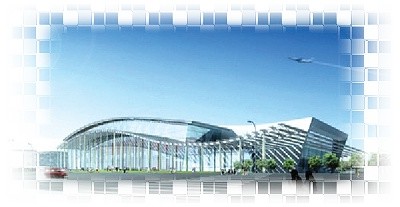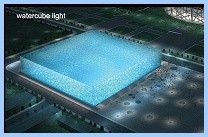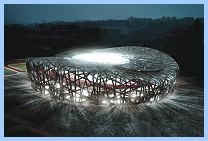| The Golden Age Lifestyle Beijing Olympics
Embraces
|

As global awareness of environmental protection has increased, Beijing has shown the international community that its 2008 Olympic Games would be held as the Green Olympics, High-tech Olympics and People’s Olympics. Construction projects for the Olympics meet the requirements of this eco-friendly era in terms of energy conservation, environmental and ecological protection, and efficient use of water resources.
The main Olympics venue will be the Beijing National Stadium, also known as the Bird’s Nest, which is designed for rainwater recuperation. Rainwater will be collected and treated for use in watering the grass on the premises, cooling ventilation systems, and for bathroom use, greenery projects and fire-fighting. This is expected to save approximately 60,000 tons of water each year.
 |
The National Aquatics Center – or the Water Cube – is covered by ETFE foil membranes*. Sunlight penetrating the membranes makes artificial lighting unnecessary in most parts of the Center in the day time and also keeps the water temperature of the swimming pools to a regulated degree. This design reduces electric power consumption by 30 percent. Besides, water recycling through the dual filtering system of the swimming pools and an underground rainwater recuperation system reflect an ingenious design of water and power conservation.
The National Indoor Stadium is erected on a foundation built from slag, or residue from steel-melting. This pioneering undertaking in material recycling has consumed over 80,000 tons of slag to produce a good waterproof effect. Solar panels installed on the roof can generate 100,000 kilowatts of electricity daily.
 |
Other eco-friendly facilities include
the Wrestling Gymnasium, which relies entirely on natural lighting; and
the Table Tennis Stadium, which is installed with underground heat transmission
lines that provide natural heating in winter, and disperses heat and cools
down the stadium in summer. A solar heating system comprising nearly 6,000
sq. m of solar panels will provide hot water for bathrooms in the Olympics
Village, where 16,800 athletes from various countries will be staying.
After the Olympics, this system will continue to supply hot water to more
than 2,000 households in the area. These are excellent examples of efficient
environmental protection and good use of natural resources. We hope that
the “green Olympics” will be a success and serve as an example
for the rest of the world. ![]()
* ETFE is a thin, lightweight and transparent plastic film that is considered one of the most energy-saving and environmentally-friendly construction materials. When two or multiple layers of ETFE are installed together and the space between them inflated, they form durable air cushions that can be used to cover the outer walls and roofs of buildings.
| << | Contents | >> |
|
Refer this page to friends
|
||